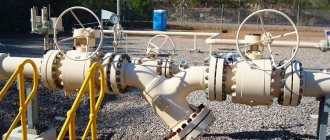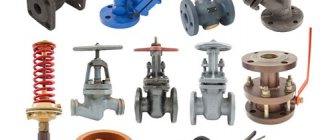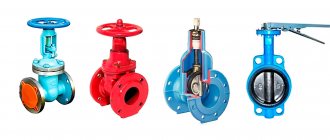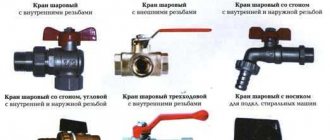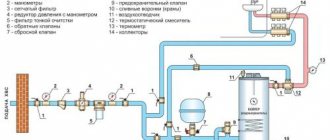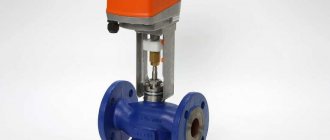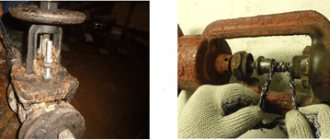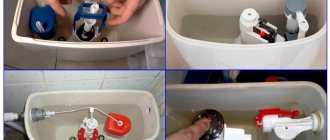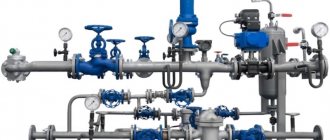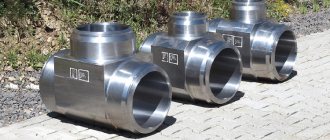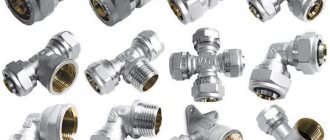A pipeline network for any purpose is a serious engineering structure in which each part bears a certain functional load and is responsible for the quality, safety, and uninterrupted operation of the network. But the main line does not consist of pipes alone; fittings are also needed. The design solutions of such parts vary in complexity, material of manufacture (steel, cast iron, brass, plastic), types and purpose. It is used for steel, metal-plastic, polyethylene, polypropylene systems. A wide range of these products are classified, which helps to understand the question of pipeline fittings: what is it?
Each pipeline is equipped with different types of valves - shut-off, control, etc.
Classification of pipeline fittings
What is “pipeline fittings”? This is a mechanism whose work is to change the cross-section of the conductive lumen of the pipeline in order to organize the movement (adjustment, shutdown, mixing, discharge, distribution) of one or more flows of liquid, gaseous, powdery substances, according to the technical parameters of pressure, temperature, power, direction and physics. -chemical state of the working environment. The classification is quite extensive; such elements are divided according to different criteria.
1. By functions performed:
- shut-off – hermetically blocks the movement of a substance in the line at the moment of closing, also ensures passage without resistance when opening the mechanism (faucet, valve, damper, valve). The need for this process arises periodically due to technical requirements. The shut-off element includes an element for draining the working medium from the container or entering the control and measuring instruments;
- regulating – allows you to change the parameters of temperature, pressure, pressure, level, flow of the transported substance (valve, self-acting valve, condensate drain, level regulator). Reducing or throttling valves of pipelines regulate pressure through hydraulic resistance;
- safety - automatically triggered to open the valve when the pressure exceeds the norm, during which excess conductive mass is discharged (safety valve, diaphragm fuse, bypass valve);
- protective - turns off the equipment, a section of the pipeline in the event of an emergency change in the parameters of the flowing substance or blocks the reverse flow of the working medium, protecting the pipeline and equipment from emergency situations (check valve, pneumatic valves, shut-off valve);
- phase separation – separates a conductive medium that is in different phases of state (removal of condensate, oil/gas/air separation);
- distribution and mixing - distributes the flow of a substance in given directions, or mixes the flows into a single one (distribution tap/valve, mixer, three-way fittings);
- control – determines the level, movement of the conducted mass (level sensor, plug valves).
Control valves allow you to monitor temperature, pressure and other parameters of the pipeline
2. By control method:
- controlled - activated by manual manipulation or using a mechanical (pneumatic, hydraulic, electric, electromagnetic) drive. Remote control can be carried out by a drive installed separately from the pipeline fittings, connected by bearings, shafts, cables, and gears. Most of the products, designed for pipes with a diameter of no more than 400 mm, are controlled by a manual drive; the process is slow and requires significant effort ;
- automatic – operates autonomously under the influence of the working environment or using automatic triggering devices.
3. According to the method of connection to the pipeline:
- coupling - connection with a coupling with a thread inside, applicable to Ø no more than 80 mm and operating pressure 10 atm, suitable for metal-plastic, polyethylene, polypropylene pipelines;
- flanged - a strong connection with a bolted tie; the flange connection can be disassembled and reassembled many times for repairs and cleaning of fittings. Periodic monitoring of the fasteners is necessary, as they may become loose;
- welded - parts are joined with a welding seam in a socket or butt joint, it is considered the most reliable and airtight, used for the conductivity of hazardous substances. The connection can be supplemented with a backing ring to prevent distortion in the joining of parts; this method is used when laying pipelines for nuclear power plants;
- pin-type - a method of connecting small-sized elements operating under high pressure (instrumentation and control) using connecting pipes with external threads and a collar;
- fitting - used for fittings with a diameter of no more than 15 mm in laboratory pipelines. Threaded connection.
Flange connection refers to dismountable fastenings; fittings installed using this method are easy to maintain and replace
4. According to the sealing method:
- stuffing box - achieved by sealing the contact between the rod and the spindle with stuffing box packing (cords made of asbestos or hemp fibers, impregnated with a sealing compound, fluoroplastic packing);
- membrane - sealing due to a membrane (elastic elastic disk), which is clamped between the cover and the valve body;
- bellows - moving elements are sealed with a bellows assembly (corrugated tube);
- hose - the design of the fittings includes an elastic hose, which is pinched, hermetically cutting off the flow.
5. By area of application:
- special - manufactured to order with specific requirements to perform specific tasks. Pipeline fittings of this type are used in laboratory research, testing, the defense complex, and nuclear power plants;
- general purpose – serially produced products that are widely used in industry, housing and communal services systems (plumbing, heating), and other manufacturing industries. These include:
- steam-water - widely used in all areas where the pipeline operates with water, designed for a different range of diameters and operating pressure;
- gas – applicable to gas supply pipelines with requirements for fire hazardous and explosive environments. Features a strong, hermetically sealed connection;
- oil - fittings resistant to aggressive environments, installed on a pipeline with an oil flow or oil products;
- chemical - developed from oxidation-resistant materials for chemical industry pipelines with a very aggressive working environment;
- energy - a type of pipeline fittings associated with the operation of energy boilers, installations, turbines with increased pressure (more than 300 atm) and steam temperature (more than 500 ° C);
- ship - used in the fleet, shipbuilding, offshore structures in working conditions with an unstable situation and harsh maritime climate;
- tank - mounted on containers for discharging the filling medium (drainage fittings), has one connecting pipe.
10. Based on the type of movement of the working mechanism, the following types of pipeline fittings are distinguished:
- faucet - a locking element having a rotating body that moves, rotating around its axis with an arbitrary location relative to the direction of flow;
- valve - an adjustment or locking element moves perpendicular to the direction of flow, has extreme open positions. and closed;
- gate (flap, sealed valve) – the disc-shaped gate element rotates around its axis perpendicularly or at an angle relative to the flow;
- valve (shut-off valve) - a locking and adjustment body is mounted on a spindle, moves parallel to the flow back and forth, blocking the cross section in the horizontal plane. Works with gaseous and liquid media, there are valve and ball.
Depending on the type, valves and valves can operate with gaseous or liquid media
7. According to conditional pressure:
- vacuum – isolates part or all of the vacuum chamber from the pumping system to control the sequence of the pumping process;
- absolute pressure (up to 0.1 MPa) – applicable in equipment for measuring the absolute pressure of the pipeline medium;
- low pressure (up to 1.6 MPa) – household metal-plastic, polyethylene, polypropylene water pipelines and steel systems;
- medium pressure (up to 10 MPa):
- high pressure (up to 100 MPa);
- ultra-high pressure (more than 100 MPa).
8. According to operating temperature:
- cryogenic (-150°C and below);
- refrigeration equipment (from -60оС to -150оС);
- low temperature (from -20°C to -60°C);
- average temperature (up to 400oC);
- high temperature (up to 600°C);
- heat-resistant (600°C and above).
Types of locking mechanisms
Industrial valves are divided into several main groups, differing in the design of the locking mechanism:
- Valves.
- Valves.
- Cranes.
- Valves.
Valves
Gate valves are a type of locking device in which the locking part, at the moment the flow stops, moves in a perpendicular plane relative to its central axis. These types of fittings are made from structural steel, brass and cast iron in a diameter range from 15 to 2000 mm, withstand operating pressure up to 25 MPa and temperature up to 565 ºС. The valve gate can be in the form of a wedge, a disk (one or two) or a rectangular plate (gate). The running unit of such devices can be extended beyond the body parts (retractable rod) or located in the working environment (non-retractable rod).
Valves
The valves are equipped with a valve in the form of a flat plate or a conical needle, which moves back and forth parallel to the axis of the passage opening when the device is activated. The former are called disc-shaped, the latter - needle-shaped. The valve can have not only one, but also two seats, which are overlapped by two plates, respectively.
Cranes
The faucet has a locking element made in the form of a rotating body with a through hole intended for the passage of flow. The valve of such fittings can rotate around its axis, at the moment when the axis of the hole coincides with the axis of the pipeline, the valve will be in the open position, allowing the flow of the working medium to pass through it. When the hole axis is perpendicular to the impulse line axis, the valve is closed. The locking part itself may have the shape of a truncated cone, cylinder or ball.
Valves
Valves are control and shut-off valves with a threaded spindle, which serves as an element that transmits force from the actuator. The passage opening of such devices is blocked in the horizontal plane.
Flanged pipeline fittings
Flanges that complement the reinforcement structure are fastening elements in the form of metal flat rings or disks with holes around the perimeter. Bolts or studs threaded through the holes are tightened, ensuring a reliable connection. Flange fittings are a set of different types of pipeline products with this type of connection; they are common in installations operating with a wide range of pressure and temperature.
Flange fittings can be made of steel and can operate over a wide range of pressure and temperature
The ability to disassemble the fastening allows for inspection or repair of fittings and pipelines. The design, dimensions, and requirements of reinforcing flanges comply with GOST. As part of the valve body, the flanges are cast from cast iron (gray, malleable) or steel. A similar flange is welded onto the pipes.
The limiting operating parameters of cast iron and steel fittings for internal networks are given in Table No. 1.
Table 1
| Limit value Øу, mm | Material | Working pressure, atm | Operating temperature, оС |
| 200,0 | Gray cast iron | 2,4; 12,5 | Any; 300 |
| 300,0 | Gray cast iron | 7,8 | 300 |
| 400,0 | Gray cast iron | 12,5 | 200 |
| 500,0 | Gray cast iron | 4,8; 12,5 | 300; 150 |
| 600,0 | Gray cast iron | 7,8 | 150 |
| 80,0 | Malleable cast iron | 38,7 | 400 |
| 100,0 | Malleable cast iron | 24,2 | 300 |
| any | Steel | 62,0 | 450 |
Important! The installation of fittings made of ductile cast iron on an overhead pipeline is not permissible at a temperature of -30°C, and of gray cast iron -10°C; it is replaced with steel.
Flange fittings are used for pipes with a diameter of 50 mm and have impressive dimensions and weight. It is not afraid of pressure changes, the temperature of the working environment can reach 400°C, any position in space is suitable.
Marking and standard requirements
In our country, to indicate the basic data of fittings, it is customary to use a marking of 6 elements - digital and alphabetic codes:
- The first two digits indicate the type of fitting (valve, valve, damper).
- The letters following it indicate the type of material of the body parts (cast iron, steel, aluminum, bronze).
- The first number behind the letters is the type of drive (mechanical, pneumatic, electric).
- The next two digits are the number of the pipeline product according to the TsKBA catalog.
- One or two letters - the type of material for sealing gaskets.
- The subsequent letter designation is the type of coating of the internal surfaces of the housing.
Example of marking of fittings: 30s41nzh Dy150 - steel valve, model number - 41, stainless steel sealing parts, nominal diameter 150 mm.
GOST standards
Technical conditions for the production of TA are regulated by GOST R 55018-2012.
Requirements for the main parameters of pipeline fittings are indicated for:
- Gate valve - in GOST 9698 and GOST 28308.
- Shut-off valves - in GOST 9697 and GOST 28291.
- Regulatory - in GOST 12893 and GOST 23866.
- Safety fittings - in GOST 31294.
- Butterfly valves - in GOST 12521.
- Ball and cone valves - in GOST 9702.
- Check valves and valves - in GOST 27477, GOST 22445 and GOST 28289.
Pipeline fittings
During the installation of a pipeline, it becomes necessary to connect pipes of different materials (steel, metal-plastic, polyethylene, polypropylene) and diameters to each other, or a flange element must be built into the network in an area of particular importance where an emergency situation is possible. In this case, connecting fittings are used - auxiliary joining parts (flange adapters, clamps, couplings, plugs, bends, crosses, tees) that do not have a locking and regulating mechanism in their design.
Steel connecting elements are suitable for any type of pipeline, as they are durable and can withstand high loads
Such fittings allow for quick, durable installation, replacement of parts, inspection and repair of the pipeline. The connection method is chosen for each type of pipe according to its intended purpose. The preferred connection for metal-plastic pipes is crimp, and for polypropylene pipes, welded. The joint turns out to be solid, airtight, and durable. The diameter of the connecting fittings varies from 25 to 2021 mm, the nominal pressure is from 1 MPa to 4 MPa . Material of manufacture: cast iron, steel, plastic. Connection type – threaded, flanged, crimp.
Connecting pipeline fittings made of stainless steel are especially durable, resistant to aggressive environments, corrosion, temperature, wear, and therefore are indispensable in the chemical, oil and gas, food, pharmaceutical industries, as well as nuclear power plants.
What materials is it made from?
The main requirement for the body of pipeline fittings is high strength. It is primarily affected by mechanical stresses associated with the parameters of the transported substance, installation forces and dynamic loads that arise during the operation of moving units and parts in its cavity. Therefore, for the manufacture of cases, different types of metals are often used, less often polymer materials, ceramics and glass.
Products with a plastic body are inexpensive, but their strength characteristics are not enough to work on high-pressure pipelines. Rare types of glass and ceramic fittings are inert to aggressive environments, and therefore are used for many technological processes in chemical production.
Of the metals for the manufacture of pipeline fittings, non-ferrous metals were initially used - brass, lead, bronze. These are corrosion-resistant, pliable and easy to process materials. Products made from them last a long time and have an attractive appearance.
But more often the body of industrial valves is made:
- Steel - from ordinary carbon, alloy, stainless, heat-resistant steel.
- Cast iron - made of gray (SG), malleable (DC) or high-strength cast iron with the inclusion of nodular graphite (SC).
Valves with a steel body can be used for operation at significant pressure levels and over a wider temperature range than with a cast iron body. However, cast iron products are cheaper.
There are also types of pipeline fittings, the body parts of which are made of aluminum and titanium.
Sealing surfaces can be stamped from elastic materials (rubber, fluoroplastic, ebonite, Teflon), and also formed by spraying copper or steel alloys. Lubricants for pipeline fittings are made based on petroleum products.
Stainless steel pipeline fittings
The use of stainless steel made it possible to obtain a qualitatively different type of product that does not interact with the working environment (without changing its properties). In the food industry, such pipeline parts are irreplaceable; they are environmentally safe, chemically inert, and stable in all respects.
Stainless high-alloy steel fittings (flanged, connecting, taps, gates, valves, steam traps) are included in a stainless pipeline transporting drinking water, dairy products, oils, alcohol with the ability to clean the system after the production cycle. In the brewing and wine industry, stainless steel parts make up systems with temperature, pressure, distribution, and mixing controls.
Of course, stainless steel parts are also applicable to domestic and industrial plumbing and heating systems.
Stainless steel fittings are suitable for use in the food industry, household plumbing and heating systems
Pipe fittings for nuclear power plants
The operation of a nuclear power plant (NPP) is a complex energy production of increased danger. All equipment must work exactly like a clock, and the pipeline network is no exception. It contains a large number of fittings, units, and instrumentation.
Requirements for installing pipeline fittings at nuclear power plants:
- the movement of the working medium must correspond to the index arrow on the body of the part;
- It is prohibited to use valves for purposes other than their intended purpose (shut-off valves as control valves);
- all types of parts must be freely accessible;
- High temperature fittings must be covered with a removable, dismountable structure with thermal insulation.
The connection of parts of the system with medium and high pressure is welded (the ends of the valves for nuclear power plants are welded) or flanged with the lowest risk of leaks. The material used is high-quality steel, resistant to aggressive environments, loads, and wear.
Safety and protective fittings play an important role. To prevent excess pressure and the occurrence of an emergency, two safety valves (pulse, lever, spring) are installed on the steam generators of a double-circuit nuclear power plant - the main and auxiliary. It is necessary to discharge steam into the bubbler. Drainage is removed from the NPP circuits by two valves installed in series: first a shut-off valve, then a control valve. The shut-off valve opens completely. The number and installation locations of the fittings are clearly calculated, and a complex sealing system is used in areas of high radioactivity. Valves for nuclear power plants after repair undergo a series of pressure tests exceeding the operating pressure by 25%.
Fittings for metal-plastic pipes
Auxiliary parts for internally laid metal-plastic pipelines are used to control the flow of water or coolant when laying pipes to plumbing, water heating, heating, and drainage devices. These are taps, valves, shutters, flaps, gate valves, mixers, pressure regulators, check valves, designed to operate with a medium temperature of up to 95 ° C and a pressure of 16 atm.
When installing pipelines made of metal-plastic pipes, brass fittings are most often used
The fittings of metal-plastic pipelines used in domestic conditions are small in size and aesthetically pleasing, have threaded and press connections, and symbols, which greatly simplifies installation. Made from nickel-plated brass, resistant to corrosion. The most commonly used are various types of connecting fittings and ball valves.
Important! It is better to choose fittings for metal-plastic pipes from a trusted manufacturer; a quality product has a long service life.
Fittings for polyethylene pipes
As in metal-plastic pipelines, fittings for polyethylene pipes are used in pressure and non-pressure systems. The widest range of connecting elements for clamping, welding or flange connections. The welded connection of polyethylene products is considered the most reliable, airtight, and forms a single cast body.
Regulation of the movement of the medium flow of these pipelines is carried out using polyethylene (HDPE) or brass taps, valves, dampers, designed for pressure up to 16 atm and flow temperature of 45 - 80 ° C (hot water supply), not subject to corrosion. Ball valves made entirely of polyethylene may be subject to deformation if the temperature conditions are not maintained.
How to maintain and repair
To identify malfunctions, pipeline fittings are periodically inspected to determine the integrity of the housing, the tightness of connections, the presence of lubricant in the electric drive and the ability to carry out repairs on site. If this is not possible, then the device is dismantled completely or partially. In order not to stop the operation of the system, a sliding insert is installed in the pipeline during repair work, consisting of a piece of pipe and two flanges, one on each side.
When eliminating a leak of medium at the point of contact between the neck of the product and the cover or through the gap between the body and the spindle, replace the stuffing box. A damaged spindle can be replaced or repaired by welding metal. Cracks in the body of steel reinforcement are welded, which is impossible to do for cast iron products; replacement will be required here. If a leak is detected at the flange junction, tighten the flange joint.
Fittings for polypropylene pipes
Shut-off and control pipeline fittings, types of connecting fittings for polypropylene pipes are the same as for polyethylene pipes. Designed for pressure up to 20 atm, medium temperature up to 90°C. Many manufacturers now produce models of polypropylene elements with a holder made of hot-pressed nickel-plated brass, which forms a monolithic structure that is resistant to thermal deformation.
Plastic pipelines can function quite successfully with fittings made from the same polymers
The presence of built-in brass threaded dismountable connections in polypropylene connecting parts makes it possible to equip a plastic pipeline with metal fittings. The cost of polyethylene and polypropylene auxiliary parts is significantly lower than their metal counterparts.
Symbols for pipeline fittings
To correctly select fittings for steel, metal-plastic, polyethylene, polypropylene and other pipelines, symbols are used - a summary of the technical parameters of the details of the TsKBA classification (Central Design Bureau for Valve Manufacturing). The cipher contains a specific sequence of alphabetic and digital values. Two numbers in front - the type of fittings, followed by one or two letters - the material of the product, then one or two numbers - the serial number of the fittings of this type in the catalog, the final two letters - the material of the seal or the inner surface of the product, Roman numeral - the design of the product, Arabic numeral – design of various environments, modes.
Designation example: 15s979nzh – carbon steel shut-off valve with electric drive, fitting number (79) and stainless steel seal.
Schematic (graphic) symbols for the specification and detailed design of the system developed by TsKBA are also used. The designations constitute a unified documentation system, enshrined in GOST.
All types of pipeline fittings are designed for specific operating conditions; they participate in the uninterrupted and safe operation of systems for various purposes in all areas of activity, making them more efficient.
Production methods
Existing technologies for the production of pipeline fittings ensure strict compliance with its geometric dimensions and mechanical properties. The following methods are used to manufacture the body:
- Forgings.
- Casting.
- Welding.
- Stampings.
- Their combination (cast-stamp-welded, stamp-welded body).
Steel casings of pipeline circuits are mainly stamped. The manufacturing technology of a stamped body consists of cutting a pipe blank, heating it to the plasticity temperature of the material, and thermoplastic deformation on a crimping punch shaped like its inner surface. Then, using a molding punch, the pipe is extruded. The blank formed in this way is removed from the stamp, subjected to shot blasting and mechanical processing, and the application of a protective coating.
Cast iron bodies are often cast.
